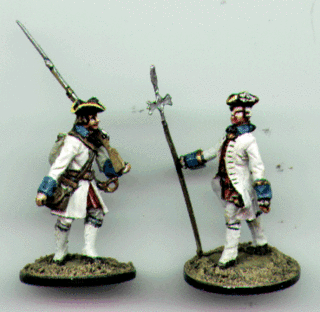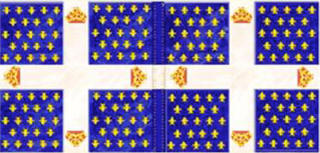Short Battle Report - The First Battle of AlzheimPrompted by the turning of their coats by the entire von KleistFreiKorps (now calling themselves the Palpable Pandours), PrinzFreidrich-August of Anhalt-Bootcamp declared war and vengeance on theHigh Grand Supreme Duchy of Soubre-Whelm.
Colonel Caper of thePalpable Pandours was hot-footing it for the border between the two mighty statelets. Hot on their heels rode the avant-garde of theAnhalt-Bootcamp Grand Army, lusting to chastise them severely fortheir lack of fidelity.The two sides met at the border-town of Alzheim for the first skirmish of what promised to be an interminable struggle fit for the employment of many generals for years to come.
The forces were:
Anhalt-Bootcamp
C.O. General-Oberst Schlitz von Apfel-Strudel
Infantry Regiment 13 "Itzenplitz" (40 Figs)
Dragoon Regiment 5 (2 Sqns or 12 Figs)
Nr 1 Section, "A" Battery the Princely Artillery. (1Howitzer)
High Grand Supreme Duchy of Soubre-Whelm
C.O. Brigadier Creosote Force-Majeur
Infantry Regiment "Languedoc" (30 Figs)
Palpable Pandours Horse Grenadiers (1 Sqn or 6 Figs)
Palpable Pandours (12 Figs) - Col. Caper
1er Section, "A" Batterie, His Lordship (bless him) theDukes' Own Artillery. (1 Howitzer)
The opening moves of the battle saw both sides advancing toward eachother with the greatest elan. The troops of High Grand Supreme Duchyof Soubre-Whelm anchored their right flank on the town of Alzheim andtheir left (including the artillery on the woods. The rather relivedPandours rushed to line the woods and hopefully make any enemyattempt on the artillery an experience filled with discomfort!
In sublime ignorance of this fact (or goaded on by the noble cry oftheir Prince - "I paid for you buggers and I expect to see you do something!") Dragoon Regiment 5 charged the Soubre-Whelm gun. On their way in they collected two casualties from a popping fire from the Palpable Pandours and a great big blast of cannister from the gun that removed a further four men from their saddles!The inexplicable decision of the Horse Grenadiers not to counter-charge left Brigadier Creosote Force-Majeur livid, but resigned to firing off Regiment Languedoc at IR13. The latter replied with enthusiasm such that the weaker Languedoc was shattered and fell back. The weakened but still formidable IR13 held firm and looked likely to follow on the heels of the beaten-up Languedoc.
Those remnants of Dragoon Regiment 5 who'd reached the gun alive were hot for action and rapidly despatched three of it's gunners, with the fourth running for his life! At this point I decided the battle was pretty much over, withRegiment Languedoc in tatters and the remaining gunner of the Soubre-Whelm artillery taking to his heels. It thus fell to the Palpable Pandours light infantry and the Horse Grenadiers to cover the retirement. It looked however to von Apfel-Strudel that in view ofthe battering his own force had taken, it might be for the best if his forces were to partake of the delights of Alzheim - he himself knew of a very nice, snug little Inn.
 RSM Figure Conversion
RSM Figure Conversion











